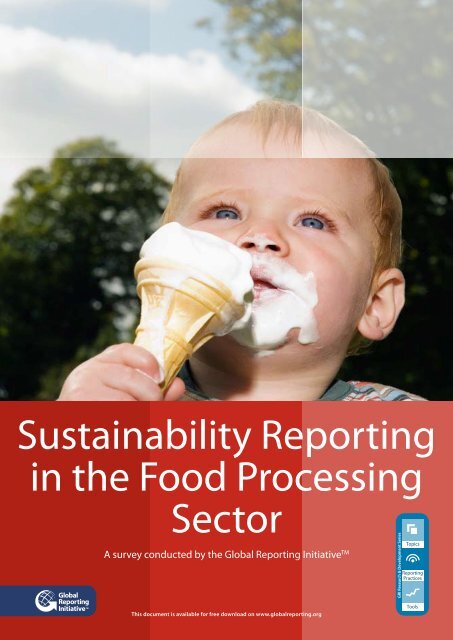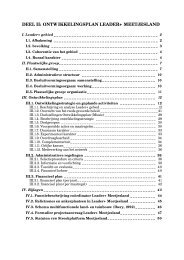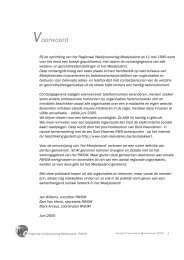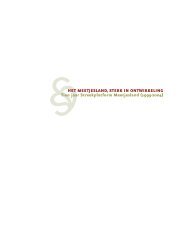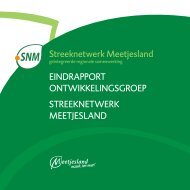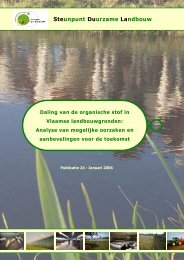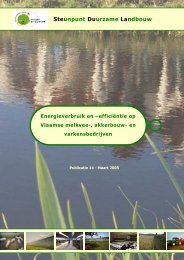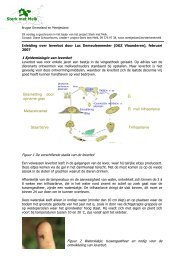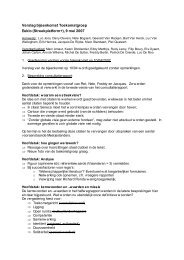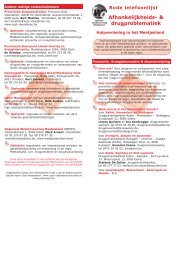Sustainability Reporting in the Food Processing Sector - Global ...
Sustainability Reporting in the Food Processing Sector - Global ...
Sustainability Reporting in the Food Processing Sector - Global ...
You also want an ePaper? Increase the reach of your titles
YUMPU automatically turns print PDFs into web optimized ePapers that Google loves.
<strong>Susta<strong>in</strong>ability</strong> <strong>Report<strong>in</strong>g</strong><br />
<strong>in</strong> <strong>the</strong> <strong>Food</strong> Process<strong>in</strong>g<br />
pics<br />
ends<br />
ools<br />
GRI Research & Development<br />
GRI GRI Research Research & Development Series Series<br />
<strong>Sector</strong><br />
Topics<br />
Topics<br />
A survey conducted<br />
Topics<br />
by <strong>the</strong> May <strong>Global</strong> 7-9 2008 <strong>Report<strong>in</strong>g</strong> Topics Initiative TM<br />
Topics<br />
Topics<br />
<strong>Report<strong>in</strong>g</strong><br />
Practices<br />
Tools<br />
The Amsterdam <strong>Global</strong> Conference on<br />
GRI Research GRI Research & Development<br />
& Development<br />
Trends<br />
<strong>Report<strong>in</strong>g</strong><br />
Practices<br />
Trends<br />
<strong>Report<strong>in</strong>g</strong><br />
<strong>Report<strong>in</strong>g</strong> Practices<br />
Practices<br />
Tools<br />
Tools<br />
This document Tools is available for free download on www.globalreport<strong>in</strong>g.org<br />
Tools<br />
Tools<br />
GRI Research GRI Research<br />
GRI Research & Development & & Development<br />
Series Series Series<br />
<strong>Susta<strong>in</strong>ability</strong> <strong>Report<strong>in</strong>g</strong> Today: The Readers’ Verdict<br />
GRI Research & Development Series<br />
GRI Research & Development Series<br />
Topics<br />
Topics<br />
<strong>Report<strong>in</strong>g</strong><br />
Practices<br />
<strong>Report<strong>in</strong>g</strong><br />
Practices<br />
Tools<br />
Tools
<strong>Susta<strong>in</strong>ability</strong> <strong>Report<strong>in</strong>g</strong> Today: The Readers’ Verdict<br />
About GRI’s Research and<br />
Development Publication<br />
Series<br />
GRI Research & Development<br />
GRI’s world class research and development<br />
program supports a commitment to cont<strong>in</strong>uous<br />
improvement by <strong>in</strong>vestigat<strong>in</strong>g challeng<strong>in</strong>g issues<br />
around report<strong>in</strong>g and <strong>in</strong>novat<strong>in</strong>g new ways to<br />
apply <strong>the</strong> GRI <strong>Report<strong>in</strong>g</strong> Framework <strong>in</strong> conjunction<br />
with o<strong>the</strong>r standards.<br />
Publications <strong>in</strong> <strong>the</strong> GRI Research and Development<br />
Series are presented <strong>in</strong> three categories:<br />
Topics<br />
<strong>Report<strong>in</strong>g</strong><br />
Practices<br />
Tools<br />
Research and implications on report<strong>in</strong>g<br />
related to subject such as biodiversity<br />
and gender<br />
Track<strong>in</strong>g report<strong>in</strong>g practice and<br />
implementation, and assess<strong>in</strong>g future<br />
scenarios.<br />
Guidance for us<strong>in</strong>g <strong>the</strong> GRI <strong>Report<strong>in</strong>g</strong><br />
Framework <strong>in</strong> comb<strong>in</strong>ation with o<strong>the</strong>r<br />
standards<br />
Copyright<br />
This document is copyright-protected by Sticht<strong>in</strong>g<br />
<strong>Global</strong> <strong>Report<strong>in</strong>g</strong> Initiative (GRI). The reproduction<br />
and distribution of this document for <strong>in</strong>formation<br />
and/or use <strong>in</strong> prepar<strong>in</strong>g a susta<strong>in</strong>ability report<br />
is permitted without prior permission from GRI.<br />
However nei<strong>the</strong>r this document nor any extract<br />
from it may be reproduced, stored, translated, or<br />
transferred <strong>in</strong> any form or by any means (electronic,<br />
mechanical, photocopies, recorded, or o<strong>the</strong>rwise)<br />
for any o<strong>the</strong>r purpose without prior written<br />
permission from GRI.<br />
<strong>Global</strong> <strong>Report<strong>in</strong>g</strong> Initiative, <strong>the</strong> <strong>Global</strong> <strong>Report<strong>in</strong>g</strong><br />
Initiative logo, <strong>Susta<strong>in</strong>ability</strong> <strong>Report<strong>in</strong>g</strong> Guidel<strong>in</strong>es,<br />
and GRI are trademarks of <strong>the</strong> <strong>Global</strong> <strong>Report<strong>in</strong>g</strong><br />
Initiative.<br />
© 2008 GRI<br />
This document <strong>Susta<strong>in</strong>ability</strong> <strong>Report<strong>in</strong>g</strong> <strong>in</strong> <strong>the</strong> <strong>Food</strong><br />
Process<strong>in</strong>g <strong>Sector</strong>’, falls under <strong>the</strong> <strong>Report<strong>in</strong>g</strong> Practices<br />
category.<br />
2<br />
© 2008 GRI
Acknowledgement<br />
The <strong>Global</strong> <strong>Report<strong>in</strong>g</strong> Initiative<br />
The <strong>Global</strong> <strong>Report<strong>in</strong>g</strong> InitiativeTM (GRI) is a<br />
multi-stakeholder non-profit organization that<br />
develops and publishes guidel<strong>in</strong>es for report<strong>in</strong>g on<br />
economic, environmental, and social performance<br />
(‘susta<strong>in</strong>ability performance’). The GRI’s <strong>Susta<strong>in</strong>ability</strong><br />
<strong>Report<strong>in</strong>g</strong> Guidel<strong>in</strong>es had been used by over<br />
1000 organizations worldwide, with many more<br />
organizations consider<strong>in</strong>g <strong>the</strong>m <strong>in</strong>formally dur<strong>in</strong>g<br />
<strong>the</strong> preparation of <strong>the</strong>ir public reports. The guidel<strong>in</strong>es<br />
are developed through a unique multi-stakeholder<br />
consultative process <strong>in</strong>volv<strong>in</strong>g representatives from<br />
report<strong>in</strong>g organizations and report <strong>in</strong>formation<br />
users from around <strong>the</strong> world. First published <strong>in</strong> 2000<br />
and <strong>the</strong>n revised <strong>in</strong> 2002, <strong>the</strong> guidel<strong>in</strong>es have now<br />
entered <strong>the</strong>ir third generation, referred to as <strong>the</strong> GRI<br />
G3 Guidel<strong>in</strong>es which were released <strong>in</strong> October 2006.<br />
<strong>Susta<strong>in</strong>ability</strong> <strong>Report<strong>in</strong>g</strong> <strong>in</strong> <strong>the</strong> <strong>Food</strong> Process<strong>in</strong>g <strong>Sector</strong><br />
Research conducted by:<br />
Laura French, GRI<br />
Lead editors:<br />
Maaike Fleur, GRI<br />
Sean Gilbert, GRI<br />
Designer:<br />
Tuuli Sauren, INSPIRIT International<br />
Communications<br />
1<br />
GRI Research and<br />
Development Series<br />
I Research & Development<br />
Topics<br />
<strong>Report<strong>in</strong>g</strong><br />
Practices
<strong>Susta<strong>in</strong>ability</strong> <strong>Report<strong>in</strong>g</strong> Today: The Readers’ Verdict<br />
2<br />
© 2007 2008 GRI
Table of Contents<br />
1. Introduction 4<br />
2. Methodology 5<br />
3. Overview of <strong>Food</strong> Process<strong>in</strong>g<br />
<strong>Susta<strong>in</strong>ability</strong> Reporters 6<br />
4. Trends <strong>in</strong> <strong>Food</strong> Process<strong>in</strong>g<br />
<strong>Susta<strong>in</strong>ability</strong> <strong>Report<strong>in</strong>g</strong> 8<br />
4.1 Frequency of reported GRI Indicators 8<br />
4.2 Added report<strong>in</strong>g on sector <strong>the</strong>mes 8<br />
5. Conclusions 13<br />
List of Figures<br />
Figure I <strong>Food</strong> Process<strong>in</strong>g Reporters by<br />
Region 6<br />
Figure II <strong>Food</strong> Process<strong>in</strong>g Reporters by<br />
Sub-sector 6<br />
Figure III Number of Reporters by<br />
Sub-sector, 1991-2006 7<br />
Figure IV Frequency of <strong>Report<strong>in</strong>g</strong> 8<br />
List of Tables<br />
Table I Frequency of <strong>Report<strong>in</strong>g</strong> on<br />
Themes 9<br />
Annexes<br />
Annex I 2006 <strong>Food</strong> Process<strong>in</strong>g Reporters 14<br />
Annex II Frequency of Reported<br />
GRI Indicators 16<br />
Annex III Supply Cha<strong>in</strong> <strong>in</strong> <strong>the</strong> GRI 2002<br />
and GRI G3 18<br />
<strong>Susta<strong>in</strong>ability</strong> <strong>Report<strong>in</strong>g</strong> <strong>in</strong> <strong>the</strong> <strong>Food</strong> Process<strong>in</strong>g <strong>Sector</strong><br />
3<br />
GRI Research and<br />
Development Series<br />
I Research & Development<br />
Topics<br />
<strong>Report<strong>in</strong>g</strong><br />
Practices
<strong>Susta<strong>in</strong>ability</strong> <strong>Report<strong>in</strong>g</strong> Today: The Readers’ Verdict<br />
1. Introduction<br />
The <strong>Global</strong> <strong>Report<strong>in</strong>g</strong> Initiative’s (GRI) vision is<br />
that report<strong>in</strong>g on economic, environmental, and<br />
social performance by all organizations is as<br />
rout<strong>in</strong>e and comparable as f<strong>in</strong>ancial report<strong>in</strong>g.<br />
The GRI has pioneered <strong>the</strong> development of <strong>the</strong><br />
world’s most widely used susta<strong>in</strong>ability report<strong>in</strong>g<br />
framework, <strong>the</strong> G3 Guidel<strong>in</strong>es, and is committed to its<br />
cont<strong>in</strong>uous improvement and application worldwide.<br />
This framework sets out <strong>the</strong> pr<strong>in</strong>ciples and <strong>in</strong>dicators<br />
that organizations can use to measure and report <strong>the</strong>ir<br />
economic, environmental, and social performance.<br />
Some sectors face unique needs that require<br />
specialized guidance <strong>in</strong> addition to <strong>the</strong> universally<br />
applicable core Guidel<strong>in</strong>es. <strong>Sector</strong> Supplements<br />
respond to <strong>the</strong>se needs and are a key part of <strong>the</strong><br />
<strong>Report<strong>in</strong>g</strong> Framework, designed to complement <strong>the</strong><br />
Guidel<strong>in</strong>es.<br />
After numerous requests, GRI began explor<strong>in</strong>g<br />
<strong>the</strong> possibility of develop<strong>in</strong>g a <strong>Food</strong> Process<strong>in</strong>g<br />
<strong>Sector</strong> Supplement <strong>in</strong> <strong>the</strong> summer of 2007. For <strong>the</strong><br />
purpose of focus<strong>in</strong>g a sector supplement, a group<br />
of companies with a comparable susta<strong>in</strong>ability<br />
impact is sought. For that reason, <strong>the</strong> focus here is<br />
on companies without retail activities or process<strong>in</strong>g<br />
tobacco or alcohol. In <strong>in</strong>itial conversations,<br />
questions were raised regard<strong>in</strong>g <strong>the</strong> current level<br />
of report<strong>in</strong>g and <strong>the</strong> content of <strong>the</strong> published<br />
susta<strong>in</strong>ability reports <strong>in</strong> <strong>the</strong> <strong>Food</strong> Process<strong>in</strong>g sector.<br />
To answer <strong>the</strong>se questions, GRI compiled an<br />
overview of report<strong>in</strong>g <strong>in</strong> <strong>the</strong> food sector <strong>in</strong> 2006<br />
to serve as a resource for <strong>the</strong> development of<br />
<strong>the</strong> <strong>Sector</strong> Supplement. The research assessed<br />
trends <strong>in</strong> use of some GRI <strong>in</strong>dicators and how <strong>Food</strong><br />
Process<strong>in</strong>g companies report on sector-specific<br />
<strong>the</strong>mes.<br />
The results of all analyses are presented <strong>in</strong> this<br />
report, beg<strong>in</strong>n<strong>in</strong>g with an overview of <strong>the</strong> 60 food<br />
process<strong>in</strong>g reports which cover <strong>the</strong> year 2006. This<br />
is followed by an exam<strong>in</strong>ation of report<strong>in</strong>g trends<br />
among a sample of 20 food process<strong>in</strong>g reporters.<br />
The research uncovered a number of sector-specific<br />
issues that regularly appear <strong>in</strong> reports, but are<br />
not covered <strong>in</strong> <strong>the</strong> GRI Guidel<strong>in</strong>es and should be<br />
considered for <strong>in</strong>clusion through a supplement.<br />
4<br />
© 2008 GRI
2. Methodology<br />
GRI’s research on report<strong>in</strong>g <strong>in</strong> <strong>the</strong> food process<strong>in</strong>g<br />
sector focused on <strong>the</strong> 60 food process<strong>in</strong>g<br />
companies that had issued susta<strong>in</strong>ability reports<br />
cover<strong>in</strong>g <strong>the</strong> year 2006 (see Annex I for list).<br />
To ga<strong>in</strong> additional <strong>in</strong>sight, 20 food process<strong>in</strong>g<br />
susta<strong>in</strong>ability reports were selected for a detailed<br />
analysis focused on two questions:<br />
1)<br />
What is <strong>the</strong> frequency of report<strong>in</strong>g on GRI<br />
<strong>in</strong>dicators <strong>in</strong> food process<strong>in</strong>g reports (see 4.1)<br />
2) What <strong>the</strong>mes were <strong>in</strong>cluded <strong>in</strong> food process<strong>in</strong>g<br />
reports, and how did <strong>the</strong>se relate to <strong>the</strong> <strong>the</strong>mes<br />
covered <strong>in</strong> <strong>the</strong> G3 Guidel<strong>in</strong>es (see 4.2)<br />
The detailed analysis of <strong>the</strong> 20 reports was limited<br />
to those reports published <strong>in</strong> English. The sample<br />
was chosen to reflect a diverse geographic and subsector<br />
representation.<br />
The sample of reports <strong>in</strong>cluded ones written<br />
us<strong>in</strong>g <strong>the</strong> GRI Guidel<strong>in</strong>es as well as reports written<br />
without reference to <strong>the</strong> GRI. Information on <strong>the</strong><br />
20 selected companies, <strong>in</strong>clud<strong>in</strong>g <strong>the</strong> company<br />
location, primary sub-sector and report<strong>in</strong>g<br />
guidel<strong>in</strong>es, is marked and bolded <strong>in</strong> Annex I.<br />
To gauge report<strong>in</strong>g on GRI Indicators, <strong>the</strong><br />
content <strong>in</strong>dex of <strong>the</strong> GRI reports was exam<strong>in</strong>ed to<br />
determ<strong>in</strong>e whe<strong>the</strong>r a company had reported on<br />
a given <strong>in</strong>dicator. However, <strong>the</strong> research did not<br />
try to systematically survey <strong>the</strong> GRI Disclosures on<br />
Management Approach amongst companies. For<br />
report<strong>in</strong>g on <strong>in</strong>dicators, no dist<strong>in</strong>ction was made<br />
between “full” and “partial” report<strong>in</strong>g as described<br />
by <strong>in</strong>dividual companies, nor <strong>the</strong> manner of<br />
report<strong>in</strong>g, and if companies referred to a separate<br />
document conta<strong>in</strong><strong>in</strong>g <strong>the</strong>ir response to a given<br />
<strong>in</strong>dicator, this was also counted as report<strong>in</strong>g.<br />
Certa<strong>in</strong> assumptions were made so that<br />
<strong>in</strong>formation could be extracted from <strong>the</strong> 20<br />
reports <strong>in</strong> a consistent and standardized way.<br />
In order to track companies’ report<strong>in</strong>g on sector<br />
<strong>the</strong>mes, only <strong>the</strong> actual report was read and <strong>the</strong><br />
research did not extend to review<strong>in</strong>g <strong>the</strong> content<br />
of o<strong>the</strong>r documents alluded to or l<strong>in</strong>ked to <strong>in</strong><br />
<strong>the</strong> report. The prelim<strong>in</strong>ary research results were<br />
discussed by companies and stakeholders from<br />
<strong>the</strong> <strong>Food</strong> Process<strong>in</strong>g sector, and <strong>the</strong> 20 sample<br />
companies were offered <strong>the</strong> opportunity to do<br />
an accuracy check.<br />
<strong>Susta<strong>in</strong>ability</strong> <strong>Report<strong>in</strong>g</strong> <strong>in</strong> <strong>the</strong> <strong>Food</strong> Process<strong>in</strong>g <strong>Sector</strong><br />
5<br />
GRI Research and<br />
Development Series<br />
I Research & Development<br />
Topics<br />
<strong>Report<strong>in</strong>g</strong><br />
Practices
<strong>Susta<strong>in</strong>ability</strong> <strong>Report<strong>in</strong>g</strong> Today: The Readers’ Verdict<br />
3. Overview of <strong>Food</strong><br />
Process<strong>in</strong>g<br />
<strong>Susta<strong>in</strong>ability</strong> <strong>Report<strong>in</strong>g</strong><br />
Follow<strong>in</strong>g <strong>the</strong> global trend <strong>in</strong> environmental<br />
awareness, paired with heightened consumer<br />
consciousness, food companies are <strong>in</strong>creas<strong>in</strong>gly<br />
fac<strong>in</strong>g new expectations and seek<strong>in</strong>g to<br />
proactively communicate <strong>the</strong> economic, social and<br />
environmental performance of <strong>the</strong>ir bus<strong>in</strong>esses.<br />
The global food <strong>in</strong>dustry, an enterprise <strong>in</strong> which<br />
over 4 billion tons of products are moved from field<br />
to table each year, can be broken <strong>in</strong>to three ma<strong>in</strong><br />
sectors: agriculture, food process<strong>in</strong>g, and food<br />
retail & foodservice. Sitt<strong>in</strong>g <strong>in</strong> between agriculture<br />
and food retail and foodservice, food process<strong>in</strong>g<br />
companies face demands placed on <strong>the</strong>m by<br />
partners both upstream and downstream, and are<br />
<strong>the</strong>refore central to <strong>the</strong> discussion of susta<strong>in</strong>able<br />
food production.<br />
The food process<strong>in</strong>g sector can be fur<strong>the</strong>r<br />
broken down by sub-sectors based on <strong>the</strong> ma<strong>in</strong><br />
products companies process: agricultural crops,<br />
semi-processed products, meat, fish, dairy, and<br />
beverages. Some companies provide multiple<br />
products but have for <strong>the</strong> purpose of this research<br />
been classified with<strong>in</strong> <strong>the</strong> sub-sector represent<strong>in</strong>g<br />
<strong>the</strong> largest portion of sales volume. Alcohol,<br />
pharmaceutical and tobacco process<strong>in</strong>g companies<br />
may have overlapp<strong>in</strong>g activities with companies <strong>in</strong><br />
<strong>the</strong> food process<strong>in</strong>g sector, but were excluded here<br />
as <strong>the</strong>y face different susta<strong>in</strong>ability challenges.<br />
Upon exam<strong>in</strong>ation of susta<strong>in</strong>ability report<strong>in</strong>g<br />
practices <strong>in</strong> <strong>the</strong> food process<strong>in</strong>g sector, it was found<br />
that 60 companies produced reports cover<strong>in</strong>g <strong>the</strong><br />
year 2006. This <strong>in</strong>cludes both GRI and non-GRI<br />
based reports. Some companies started report<strong>in</strong>g<br />
as early as 1991, however, companies have, on<br />
average, around 4 years of report<strong>in</strong>g experience.<br />
Half of <strong>the</strong> food process<strong>in</strong>g reporters operate <strong>in</strong> <strong>the</strong><br />
agricultural crops sub-sector and <strong>the</strong> large majority<br />
of reporters were based <strong>in</strong> Europe. The follow<strong>in</strong>g<br />
charts highlight this geographic and sub-sector<br />
distribution.<br />
63<br />
16<br />
5<br />
1<br />
5<br />
3<br />
Beverages<br />
Meat 10%<br />
5%<br />
Fish 5%<br />
Semi-processed 7%<br />
products<br />
Dairy<br />
23%<br />
50%<br />
Agricultural Crops<br />
Europe North South Africa Australia<br />
America America<br />
Asia<br />
Figure I: 2006 <strong>Food</strong> Process<strong>in</strong>g Reporters<br />
by Region<br />
Figure II: 2006 <strong>Food</strong> Process<strong>in</strong>g Reporters<br />
by Sub-sector<br />
Goals and<br />
Performance<br />
0% 10% 20% 30% 40% 50%<br />
Organizational<br />
Responsibility<br />
Tra<strong>in</strong><strong>in</strong>g and<br />
Awareness<br />
6<br />
© 2008 GRI<br />
12%<br />
47%<br />
23%<br />
Agricultural C rops<br />
Half Products<br />
Dairy<br />
Fish
63<br />
1. Introduction<br />
Europe Africa Australia<br />
16<br />
North<br />
America<br />
5<br />
South<br />
America<br />
1<br />
5<br />
3<br />
Asia<br />
As to <strong>the</strong> size and profile of reporters, slightly over<br />
half had revenues of greater than 1 billion Euros.<br />
There has been an<br />
overall <strong>in</strong>crease<br />
<strong>in</strong> report<strong>in</strong>g s<strong>in</strong>ce<br />
<strong>the</strong> first reports<br />
were issued over<br />
15 years ago by<br />
companies <strong>in</strong><br />
<strong>the</strong> agricultural<br />
process<strong>in</strong>g and<br />
<strong>the</strong> beverage<br />
sub-sectors. Most<br />
of <strong>the</strong> reports<br />
70<br />
60<br />
50<br />
40<br />
30<br />
20<br />
10<br />
0<br />
were produced<br />
<strong>in</strong> 2006. It took<br />
almost 10 years<br />
for <strong>the</strong> fish and<br />
meat process<strong>in</strong>g<br />
1991 1992 1993<br />
sub-sectors to start produc<strong>in</strong>g reports, and even<br />
now, <strong>the</strong>re is not dramatic growth <strong>in</strong> <strong>the</strong> number<br />
of companies report<strong>in</strong>g on susta<strong>in</strong>ability <strong>in</strong> <strong>the</strong>se<br />
sub-sectors. In 2006, 24 food process<strong>in</strong>g companies<br />
used <strong>the</strong> GRI Guidel<strong>in</strong>es when report<strong>in</strong>g.<br />
1994 1995 1996 1997 1998 1999 2000 2001 2002 2003 2004 2005 2006<br />
Agricultural Process<strong>in</strong>g Beverages Dairy Fish Half Products Meat<br />
Figure III: Number of Reporters by Sub-<strong>Sector</strong>,<br />
from 1991-2006<br />
<strong>Susta<strong>in</strong>ability</strong> <strong>Report<strong>in</strong>g</strong> <strong>in</strong> <strong>the</strong> <strong>Food</strong> Process<strong>in</strong>g <strong>Sector</strong><br />
7<br />
GRI Research and<br />
Development Series<br />
I Research & Development<br />
Topics<br />
<strong>Report<strong>in</strong>g</strong><br />
Practices
<strong>Susta<strong>in</strong>ability</strong> <strong>Report<strong>in</strong>g</strong> Today: The Readers’ Verdict<br />
4. Trends <strong>in</strong> <strong>Food</strong><br />
Process<strong>in</strong>g<br />
<strong>Susta<strong>in</strong>ability</strong> <strong>Report<strong>in</strong>g</strong><br />
In addition to provid<strong>in</strong>g an overview of report<strong>in</strong>g <strong>in</strong><br />
<strong>the</strong> <strong>Food</strong> Process<strong>in</strong>g sector for <strong>the</strong> year 2006,<br />
this research also addressed trends <strong>in</strong> report<strong>in</strong>g at<br />
20 companies (See Methodology, p. 5). In section<br />
4.1, <strong>the</strong> frequency of use of performance <strong>in</strong>dicators<br />
by GRI reporters has been exam<strong>in</strong>ed, <strong>the</strong> <strong>in</strong>dicators<br />
least reported upon <strong>in</strong> <strong>the</strong> food process<strong>in</strong>g sector<br />
are described. Section 4.2 considers specific<br />
<strong>the</strong>mes that appear most frequently <strong>in</strong> reports.<br />
These two components of this research on trends <strong>in</strong><br />
<strong>the</strong> <strong>Food</strong> Process<strong>in</strong>g susta<strong>in</strong>ability report<strong>in</strong>g offers<br />
a start<strong>in</strong>g po<strong>in</strong>t for development of <strong>the</strong> GRI <strong>Sector</strong><br />
Supplement for <strong>the</strong> <strong>Food</strong> Process<strong>in</strong>g sector.<br />
4.1 Frequency of reported GRI Indicators<br />
The <strong>in</strong>formation on <strong>the</strong> frequency of report<strong>in</strong>g<br />
various GRI <strong>in</strong>dicators was compiled by review<strong>in</strong>g<br />
<strong>the</strong> content <strong>in</strong>dexes of <strong>the</strong> reports (refer to Annex<br />
II for a detailed exam<strong>in</strong>ation). The review identified<br />
three <strong>in</strong>dicator aspects where fewer than 20% of<br />
<strong>the</strong> companies claimed to have reported on <strong>the</strong><br />
<strong>in</strong>dicators. These were:<br />
• Biodiversity<br />
• Indigenous Rights<br />
• Labor/Management Relations<br />
4.2 Added <strong>Report<strong>in</strong>g</strong> on <strong>Sector</strong> Themes<br />
With<strong>in</strong> <strong>the</strong> 20 food process<strong>in</strong>g reports considered,<br />
several sector-specific <strong>the</strong>mes appeared most often,<br />
with some <strong>the</strong>mes be<strong>in</strong>g at least partially covered<br />
by GRI G3 <strong>in</strong>dicators. It was found that <strong>the</strong> manner<br />
of report<strong>in</strong>g on <strong>the</strong>mes varied significantly from<br />
company to company: some food processors chose<br />
to provide quantitative data, facilitat<strong>in</strong>g comparison<br />
with<strong>in</strong> <strong>the</strong> sector and across time (referred to here<br />
as, “quantitative <strong>in</strong>formation”), while o<strong>the</strong>rs took a<br />
more process-based approach, offer<strong>in</strong>g case studies<br />
and detailed descriptions of policies and systems<br />
(referred to as, “qualitative <strong>in</strong>formation”).<br />
High<br />
Frequency<br />
Medium<br />
Frequency<br />
Low<br />
Frequency<br />
Method<br />
“High frequency” refers to <strong>the</strong>mes reported on by 14 or<br />
more companies out of 20. “Medium frequency” refers<br />
to <strong>the</strong>mes that were addressed by 7 to 13 companies<br />
and “low frequency” <strong>the</strong>mes were addressed by less<br />
than 7 companies. The table below identifies <strong>the</strong> most<br />
common <strong>the</strong>mes <strong>in</strong> order of frequency of report<strong>in</strong>g,<br />
as well as <strong>the</strong> correspond<strong>in</strong>g GRI <strong>in</strong>dicators, where<br />
applicable.<br />
Figure IV: Legend, Frequency of <strong>Report<strong>in</strong>g</strong><br />
On <strong>the</strong> follow<strong>in</strong>g pages a brief description is<br />
provided <strong>in</strong> order to demonstrate what <strong>the</strong> 20<br />
food process<strong>in</strong>g reporters are do<strong>in</strong>g <strong>in</strong> practice to<br />
address each sector <strong>the</strong>me. Though this research<br />
documents what companies are do<strong>in</strong>g, it was<br />
not possible to assess user satisfaction with <strong>the</strong><br />
result<strong>in</strong>g reports.<br />
High frequency <strong>the</strong>mes<br />
Sourc<strong>in</strong>g and supply cha<strong>in</strong> issues<br />
19 of <strong>the</strong> 20 companies reported on supply cha<strong>in</strong><br />
and sourc<strong>in</strong>g issues <strong>in</strong> <strong>the</strong> sector. The GRI G3 asks<br />
reporters to address supply cha<strong>in</strong> activities based<br />
on <strong>the</strong>ir def<strong>in</strong>ition of Report Boundaries.<br />
In Part 1 of <strong>the</strong> Guidel<strong>in</strong>es, Def<strong>in</strong><strong>in</strong>g Report Content,<br />
Quality and Boundary, with<strong>in</strong> <strong>the</strong> <strong>Report<strong>in</strong>g</strong> Guidance<br />
for Boundary Sett<strong>in</strong>g, <strong>the</strong> G3 states,<br />
“The approach to report<strong>in</strong>g on an entity will depend<br />
on a comb<strong>in</strong>ation of <strong>the</strong> report<strong>in</strong>g organization’s<br />
control or <strong>in</strong>fluence over <strong>the</strong> entity, and whe<strong>the</strong>r<br />
<strong>the</strong> disclosure relates to operational performance,<br />
management performance, or narrative/descriptive<br />
<strong>in</strong>formation. “<br />
8<br />
© 2008 GRI
Table I: Sample Companies, Frequency of <strong>Report<strong>in</strong>g</strong> on Themes<br />
<strong>Sector</strong> Theme<br />
Frequency of<br />
<strong>Report<strong>in</strong>g</strong><br />
Number of<br />
Reporters<br />
Relevant G3 Indicators<br />
Sourc<strong>in</strong>g & Supply Cha<strong>in</strong> Issues High 19/20 EC6, HR2<br />
<strong>Food</strong> Safety High 18/20 PR1, PR2, PR4, PR5, PR9<br />
Health & Nutrition High 16/20 PR1, PR3<br />
Transportation High 16/20 EN29<br />
Environmental Aspects of Agriculture High 15/20 EN1 - EN25, EN28, EN30<br />
Packag<strong>in</strong>g High 15/20 EN27<br />
Animal Welfare (only applicable for companies<br />
process<strong>in</strong>g animal products)<br />
It fur<strong>the</strong>r def<strong>in</strong>es “control” and “significant<br />
<strong>in</strong>fluence”:<br />
“Control: <strong>the</strong> power to govern <strong>the</strong> f<strong>in</strong>ancial and<br />
operat<strong>in</strong>g policies of an enterprise so as to obta<strong>in</strong><br />
benefits from its activities.”<br />
“Significant <strong>in</strong>fluence: <strong>the</strong> power to participate <strong>in</strong> <strong>the</strong><br />
f<strong>in</strong>ancial and operat<strong>in</strong>g policy decisions of <strong>the</strong> entity<br />
but not <strong>the</strong> power to control those policies.”<br />
In addition, <strong>the</strong> Disclosure on Management<br />
Approach prompts disclosures on supply cha<strong>in</strong><br />
monitor<strong>in</strong>g and two of <strong>the</strong> Performance Indicators<br />
<strong>in</strong> <strong>the</strong> G3 Guidel<strong>in</strong>es refer specifically to suppliers.<br />
These are,<br />
EC6<br />
HR2<br />
Policy, practices, and proportion<br />
of spend<strong>in</strong>g on locally-based<br />
suppliers at significant locations of<br />
operation.<br />
Percentage of significant suppliers<br />
and contractors that have<br />
undergone screen<strong>in</strong>g on human<br />
rights and actions taken.<br />
High 9/12 N/A<br />
Advertis<strong>in</strong>g & Market<strong>in</strong>g Medium 12/20 PR6, PR7<br />
Malnutrition & Poverty Medium 10/20 N/A<br />
Fair Pric<strong>in</strong>g of Products Medium 8/20 N/A<br />
GMO Medium 7/20 N/A<br />
Chronic Disease Prevention Low 6/20 N/A<br />
Smell & Noise Low 6/20 N/A<br />
Residues Low 4/20 N/A<br />
Annex III provides detailed <strong>in</strong>formation on <strong>the</strong><br />
difference between <strong>the</strong> GRI 2002 Guidel<strong>in</strong>es and <strong>the</strong><br />
GRI G3 Guidel<strong>in</strong>es on supply cha<strong>in</strong> issues.<br />
It was difficult to strictly separate supply cha<strong>in</strong><br />
activities as a dist<strong>in</strong>ct <strong>the</strong>me <strong>in</strong> food process<strong>in</strong>g<br />
report<strong>in</strong>g. It was found that reporters addressed<br />
<strong>the</strong> supplier performance through report<strong>in</strong>g<br />
on o<strong>the</strong>r <strong>the</strong>mes, <strong>in</strong>clud<strong>in</strong>g, for <strong>in</strong>stance, food<br />
safety, environmental aspects of agriculture and<br />
packag<strong>in</strong>g, among o<strong>the</strong>rs.<br />
In practice, most companies approached this <strong>the</strong>me<br />
descriptively, outl<strong>in</strong><strong>in</strong>g <strong>the</strong>ir approach to products’<br />
supply cha<strong>in</strong>s, <strong>in</strong>clud<strong>in</strong>g <strong>the</strong> basis for choos<strong>in</strong>g<br />
certa<strong>in</strong> suppliers over o<strong>the</strong>rs. It was also common<br />
for reporters to describe <strong>the</strong>ir classification system<br />
for suppliers which is generally based on risk<br />
assessments. Ongo<strong>in</strong>g engagement and frequency<br />
of supplier audits is also based on risk assessment.<br />
Reports also <strong>in</strong>cluded descriptions of supplier<br />
codes of conduct or supplier surveys and several<br />
companies used case studies to highlight supply<br />
cha<strong>in</strong> issues.<br />
9<br />
GRI Research and<br />
Development Series<br />
I Research & Development<br />
<strong>Susta<strong>in</strong>ability</strong> <strong>Report<strong>in</strong>g</strong> <strong>in</strong> <strong>the</strong> <strong>Food</strong> Process<strong>in</strong>g <strong>Sector</strong><br />
Topics<br />
<strong>Report<strong>in</strong>g</strong><br />
Practices
<strong>Susta<strong>in</strong>ability</strong> <strong>Report<strong>in</strong>g</strong> Today: The Readers’ Verdict<br />
Quantitative <strong>in</strong>formation reported on <strong>in</strong>cluded: <strong>the</strong><br />
number of suppliers a company works with <strong>in</strong> total<br />
and <strong>the</strong>ir locations, <strong>the</strong> percentage of suppliers<br />
that have signed a supplier code of conduct with<br />
<strong>the</strong> company, and <strong>the</strong> percentage of raw materials<br />
that are supplied by fair trade certified or m<strong>in</strong>ority/<br />
women owned bus<strong>in</strong>esses. In addition, a few<br />
companies reported quantitative environmental<br />
data across a part of <strong>the</strong>ir supply cha<strong>in</strong> such as<br />
packag<strong>in</strong>g or transportation activities, if <strong>the</strong>se were<br />
sourced.<br />
control processes, as well as <strong>the</strong>ir trac<strong>in</strong>g and<br />
track<strong>in</strong>g systems for products’ raw materials.<br />
They also frequently referred to customer care<br />
telephone l<strong>in</strong>es. Some companies described <strong>the</strong>ir<br />
safety audit<strong>in</strong>g procedures, both <strong>in</strong>ternally and for<br />
suppliers. For <strong>the</strong> 5 of 18 companies that provided<br />
quantitative <strong>in</strong>formation, a few companies reported<br />
<strong>the</strong> number of recalls, <strong>the</strong> number of customer<br />
safety compla<strong>in</strong>ts, <strong>the</strong> percentage of products<br />
made right <strong>the</strong> first time, and <strong>the</strong> total cost of<br />
quality failure.<br />
<strong>Food</strong> safety<br />
<strong>Food</strong> safety was reported on at 18 of <strong>the</strong> sampled<br />
companies. This <strong>the</strong>me corresponds to G3<br />
performance <strong>in</strong>dicators on product responsibility:<br />
PR1<br />
PR2<br />
PR4<br />
PR5<br />
PR9<br />
Life cycle stages <strong>in</strong> which health and safety<br />
impacts of products and services are<br />
assessed for improvement, and percentage<br />
of significant products and services<br />
categories subject to such procedures,<br />
Total <strong>in</strong>cidents of non-compliance with<br />
regulations and voluntary codes concern<strong>in</strong>g<br />
health and safety impacts of products and<br />
services dur<strong>in</strong>g <strong>the</strong>ir life cycle, by type of<br />
outcomes,<br />
Total number of <strong>in</strong>cidents of noncompliance<br />
with regulations and voluntary<br />
codes concern<strong>in</strong>g product and service<br />
<strong>in</strong>formation and label<strong>in</strong>g, by type of<br />
outcomes,<br />
Practices related to customer satisfaction,<br />
<strong>in</strong>clud<strong>in</strong>g results of surveys measur<strong>in</strong>g<br />
customer satisfaction and<br />
Monetary value of significant f<strong>in</strong>es for<br />
non-compliance with laws and regulations<br />
concern<strong>in</strong>g <strong>the</strong> provision and use of<br />
products and services.<br />
The large majority of <strong>the</strong>se companies (13 out of<br />
18) chose to address <strong>the</strong> <strong>the</strong>me only <strong>in</strong> a qualitative<br />
manner. In practice, many companies described<br />
adherence to HACCP 1 and outl<strong>in</strong>ed <strong>the</strong>ir <strong>in</strong>ternal<br />
1<br />
HACCP: Hazard Analysis and Critical Control Po<strong>in</strong>t.<br />
Health and nutrition<br />
16 of <strong>the</strong> sampled companies reported on <strong>the</strong><br />
health and nutritional value of <strong>the</strong>ir foods for<br />
human be<strong>in</strong>gs. This <strong>the</strong>me relates to <strong>the</strong> follow<strong>in</strong>g<br />
G3 <strong>in</strong>dicators:<br />
PR1<br />
PR3<br />
Life cycle stages <strong>in</strong> which health and safety<br />
impacts of products and services are<br />
assessed for improvement, and percentage<br />
of significant products and services<br />
categories subject to such procedures) and<br />
Type of product and service <strong>in</strong>formation<br />
required by procedures, and percentage of<br />
significant products and services subject to<br />
such <strong>in</strong>formation requirements.<br />
Most (14) out of <strong>the</strong> 16 food processors that<br />
discussed health and nutrition did so <strong>in</strong> a qualitative<br />
manner. Companies tended to report descriptively<br />
on changes <strong>in</strong> product formulations or packag<strong>in</strong>g<br />
sizes of <strong>the</strong>ir foods. They also frequently described<br />
<strong>the</strong>ir approach to nutrition label<strong>in</strong>g and how foods<br />
correspond to International Dietary Guidel<strong>in</strong>es.<br />
Some companies also described <strong>the</strong>ir <strong>in</strong>itiatives<br />
to promote wellness <strong>in</strong>clud<strong>in</strong>g physical activity<br />
programs. In terms of quantitative <strong>in</strong>formation, 2<br />
companies disclosed data <strong>in</strong>clud<strong>in</strong>g <strong>the</strong> number<br />
of products that <strong>the</strong>y have deemed healthy and<br />
nutritious choices and <strong>the</strong> percentage of reduction<br />
of salt, fat and sugar <strong>in</strong> a number of <strong>the</strong>ir products.<br />
Transportation<br />
The transportation of products to customers was<br />
reported on by 15 of <strong>the</strong> sampled food processors,<br />
and is reflected <strong>in</strong> G3 <strong>in</strong>dicator<br />
10<br />
© 2008 GRI
EN29 Significant environmental impacts of<br />
transport<strong>in</strong>g products and o<strong>the</strong>r goods<br />
and materials used for <strong>the</strong> organization’s<br />
operations, and transport<strong>in</strong>g members of<br />
<strong>the</strong> workforce.<br />
Some companies described <strong>the</strong> use <strong>in</strong>termodal<br />
transportation for products, o<strong>the</strong>rs made reference<br />
to transportation as part of <strong>the</strong> product life cycle,<br />
or reported on it as a component of <strong>the</strong>ir supply<br />
cha<strong>in</strong>. Some companies offered case studies on<br />
product transportation. In terms of quantitative<br />
<strong>in</strong>formation, several companies disclosed CO 2<br />
and<br />
o<strong>the</strong>r GHG emissions <strong>in</strong> tons, <strong>in</strong> total or per product<br />
unit, aris<strong>in</strong>g from transportation activities.<br />
Environmental<br />
Aspects of Agriculture<br />
Agricultural processes and <strong>the</strong>ir environmental<br />
impacts were reported on by 15 of <strong>the</strong> companies<br />
sampled. This broad <strong>the</strong>me is reflected <strong>in</strong> a number<br />
of G3 <strong>in</strong>dicators, notably <strong>the</strong> Environmental<br />
Performance Indicators EN1 - EN25, EN28 and<br />
EN30 (too extensive to describe here).<br />
In practice, <strong>the</strong> extent of report<strong>in</strong>g seemed to<br />
vary as some companies cited that agricultural<br />
production falls outside <strong>the</strong> boundaries of report<strong>in</strong>g<br />
when raw materials are sourced. In terms of<br />
narrative report<strong>in</strong>g, 9 out of <strong>the</strong> 15 companies that<br />
addressed this topic did so by us<strong>in</strong>g qualitative<br />
<strong>in</strong>formation only. This <strong>in</strong>cludes case studies of<br />
organic or susta<strong>in</strong>able agricultural <strong>in</strong>itiatives, as<br />
well as local and <strong>in</strong>ternational agreements <strong>the</strong>y are<br />
party to and case studies of work<strong>in</strong>g <strong>in</strong> cooperation<br />
with suppliers to provide technical advice and<br />
how <strong>the</strong> companies promote best practice. In<br />
terms of quantitative <strong>in</strong>formation, 6 out of <strong>the</strong>se 15<br />
companies disclosed data <strong>in</strong>clud<strong>in</strong>g <strong>the</strong> percentage<br />
of <strong>the</strong>ir product l<strong>in</strong>e that is organic or sourced from<br />
suppliers practic<strong>in</strong>g low impact farm<strong>in</strong>g; use of<br />
fertilizers and pesticides; and f<strong>in</strong>ancial penalties<br />
<strong>in</strong>curred for poor environmental compliance.<br />
Packag<strong>in</strong>g<br />
The use and choice of material <strong>in</strong>puts for product<br />
packag<strong>in</strong>g was reported on by 16 of <strong>the</strong> sample<br />
companies. This <strong>the</strong>me relates to <strong>the</strong> G3 <strong>in</strong>dicator<br />
EN27 Percentage of products sold and <strong>the</strong>ir<br />
packag<strong>in</strong>g materials that are claimed by<br />
category.<br />
Companies tended to report descriptively on<br />
recyclability of packag<strong>in</strong>g materials and <strong>in</strong>itiatives<br />
to reduce <strong>the</strong> quantity of packag<strong>in</strong>g used. Case<br />
studies were also common <strong>in</strong> <strong>the</strong> company reports.<br />
There was one report that was devoted solely to<br />
<strong>the</strong> issue of packag<strong>in</strong>g. Qualitative data disclosed<br />
<strong>in</strong>cludes <strong>the</strong> quantity of various raw materials used<br />
<strong>in</strong> packag<strong>in</strong>g, as well as <strong>the</strong> quantity and type of<br />
f<strong>in</strong>al packag<strong>in</strong>g used and <strong>the</strong> recyclable, reusable<br />
or waste components of each package type. O<strong>the</strong>r<br />
reporters disclosed <strong>the</strong> reduction <strong>in</strong> percentage of<br />
packag<strong>in</strong>g materials that has been achieved over a<br />
number of years.<br />
Animal welfare<br />
Treatment of animals was reported on by 9 out of<br />
<strong>the</strong> 12 companies that work with animals or use<br />
animal <strong>in</strong>gredients. The <strong>the</strong>me of animal welfare is<br />
not explicitly covered <strong>in</strong> <strong>the</strong> G3 Guidel<strong>in</strong>es. Most<br />
companies that process meat or poultry described<br />
adherence to relevant laws and standards, as well<br />
as <strong>in</strong>ternal and external audit<strong>in</strong>g procedures. Some<br />
reporters listed <strong>the</strong> names of stakeholders <strong>the</strong>y<br />
work with for animal welfare.<br />
Medium frequency <strong>the</strong>mes<br />
Advertis<strong>in</strong>g & Market<strong>in</strong>g<br />
12 out of <strong>the</strong> 20 sampled companies reported <strong>the</strong>ir<br />
approach to responsible market<strong>in</strong>g of products.<br />
This <strong>the</strong>me is addressed <strong>in</strong> <strong>the</strong> follow<strong>in</strong>g G3<br />
<strong>in</strong>dicators:<br />
PR6<br />
PR7<br />
Programs for adherence to laws, standards,<br />
and voluntary codes concern<strong>in</strong>g market<strong>in</strong>g<br />
communications, <strong>in</strong>clud<strong>in</strong>g advertis<strong>in</strong>g,<br />
promotion, and sponsorship by type of<br />
outcomes.<br />
Total number of <strong>in</strong>cidents of noncompliance<br />
with regulations and<br />
voluntary codes concern<strong>in</strong>g market<strong>in</strong>g<br />
communications, <strong>in</strong>clud<strong>in</strong>g advertis<strong>in</strong>g,<br />
promotion, and sponsorship by type of<br />
outcomes.<br />
11<br />
GRI Research and<br />
Development Series<br />
I Research & Development<br />
<strong>Susta<strong>in</strong>ability</strong> <strong>Report<strong>in</strong>g</strong> <strong>in</strong> <strong>the</strong> <strong>Food</strong> Process<strong>in</strong>g <strong>Sector</strong><br />
Topics<br />
<strong>Report<strong>in</strong>g</strong><br />
Practices
<strong>Susta<strong>in</strong>ability</strong> <strong>Report<strong>in</strong>g</strong> Today: The Readers’ Verdict<br />
The companies that reported on this <strong>the</strong>me tended<br />
to do so descriptively, <strong>in</strong>clud<strong>in</strong>g discussions<br />
regard<strong>in</strong>g legal requirements for product<br />
claims, and company policy towards market<strong>in</strong>g<br />
to vulnerable groups such as new mo<strong>the</strong>rs<br />
and children. Additional descriptive report<strong>in</strong>g<br />
addressed <strong>the</strong>ir policy towards purchas<strong>in</strong>g<br />
advertis<strong>in</strong>g space – for <strong>in</strong>stance, a policy of<br />
not advertis<strong>in</strong>g <strong>in</strong> elementary schools. A few<br />
companies stated <strong>the</strong> m<strong>in</strong>imum age of children<br />
<strong>the</strong>y advertise to.<br />
Malnutrition & poverty<br />
10 out of <strong>the</strong> companies sampled reported on<br />
<strong>the</strong> <strong>the</strong>me of malnutrition, which is not explicitly<br />
covered by any G3 <strong>in</strong>dicators.<br />
Reporters generally described <strong>the</strong>ir <strong>in</strong>ternal<br />
policy on GMOs, and also <strong>the</strong>ir policy towards<br />
stakeholders or national legislation on GMOs.<br />
One reporter stated that, when GMO is used, this<br />
will be clearly stated on product labels. In terms<br />
of quantifiable data, only 1 of <strong>the</strong>se 6 listed <strong>the</strong><br />
number or percent of products that are GMO-free.<br />
Low frequency <strong>the</strong>mes<br />
Chronic disease prevention<br />
Chronic diseases and <strong>the</strong> role of food <strong>in</strong> mitigat<strong>in</strong>g/<br />
manag<strong>in</strong>g <strong>the</strong>m were reported on or referred to<br />
by 6 companies out of <strong>the</strong> total set of sampled<br />
food processors, and this <strong>the</strong>me is not covered<br />
specifically by any G3 <strong>in</strong>dicators.<br />
The report<strong>in</strong>g companies generally described <strong>the</strong>ir<br />
<strong>in</strong>tention to make products accessible to those<br />
with low purchas<strong>in</strong>g power parity, or stated that<br />
<strong>the</strong>y formulate special products to meet <strong>the</strong> needs<br />
of <strong>in</strong>dividuals with poor diets. A few companies<br />
disclosed <strong>the</strong> number of products <strong>in</strong> <strong>the</strong>ir l<strong>in</strong>e<br />
that are fortified with vitam<strong>in</strong>s and nutrients and<br />
suitable for <strong>in</strong>dividuals with poor diets.<br />
Fair & affordable price of products<br />
Mak<strong>in</strong>g products affordable to consumers with<br />
lower <strong>in</strong>comes/purchas<strong>in</strong>g power parity was<br />
reported on by 8 of <strong>the</strong> companies <strong>in</strong>vestigated.<br />
This <strong>the</strong>me is not covered specifically by any G3<br />
<strong>in</strong>dicators.<br />
The report<strong>in</strong>g generally consisted of a brief<br />
description of <strong>the</strong> company’s <strong>in</strong>tention to offer<br />
products at a fair price. One company reported<br />
specific <strong>in</strong>itiatives undertaken, <strong>in</strong>clud<strong>in</strong>g offer<strong>in</strong>g<br />
products <strong>in</strong> smaller, low-cost packages, and<br />
presented quantifiable data <strong>in</strong>clud<strong>in</strong>g a price<br />
comparison of one of <strong>the</strong>ir products <strong>in</strong> several<br />
different countries.<br />
Genetically modified organisms<br />
6 out of <strong>the</strong> 20 companies we chose to <strong>in</strong>vestigate<br />
reported on <strong>the</strong> use of genetically modified<br />
organisms (GMOs) <strong>in</strong> <strong>the</strong>ir products, or outl<strong>in</strong>ed<br />
<strong>the</strong>ir policy towards biotechnology. This <strong>the</strong>me<br />
does not directly relate to any G3 <strong>in</strong>dicators.<br />
In practice, <strong>the</strong> report<strong>in</strong>g tended to consist of a<br />
brief statement recogniz<strong>in</strong>g <strong>the</strong> role of <strong>the</strong> food<br />
process<strong>in</strong>g <strong>in</strong>dustry <strong>in</strong> fight<strong>in</strong>g chronic disease<br />
and none of <strong>the</strong> companies used quantifiable<br />
<strong>in</strong>formation to address this <strong>the</strong>me.<br />
Smell & noise compla<strong>in</strong>ts<br />
Stakeholder compla<strong>in</strong>ts regard<strong>in</strong>g odor and noise<br />
from operations were reported at 6 of <strong>the</strong> sample<br />
companies. This <strong>the</strong>me is not explicitly covered<br />
by any G3 <strong>in</strong>dicators. Most of <strong>the</strong>se companies<br />
described <strong>the</strong> processes for lodg<strong>in</strong>g and address<strong>in</strong>g<br />
compla<strong>in</strong>ts and gave examples or case studies<br />
of how <strong>the</strong>y were handled. Only half of <strong>the</strong>se 6<br />
companies disclosed quantitative <strong>in</strong>formation such<br />
as <strong>the</strong> number of compla<strong>in</strong>ts received per year and<br />
<strong>the</strong> number of facilities upgrades made <strong>in</strong> response<br />
to compla<strong>in</strong>ts.<br />
Residues<br />
Only 4 of <strong>the</strong> companies considered reported on<br />
residues. This <strong>the</strong>me is not covered specifically<br />
by any G3 <strong>in</strong>dicators. The reporters generally<br />
described <strong>the</strong>ir processes to screen for residues on<br />
ei<strong>the</strong>r raw materials or f<strong>in</strong>al products, usually as it<br />
related to food safety. In addition, <strong>the</strong>se companies<br />
generally referred to national standards and limits<br />
for residues and one company offered a case study.<br />
In terms of quantitative disclosures, only one of <strong>the</strong><br />
four companies who reported on residues offered<br />
quantitative <strong>in</strong>formation on <strong>the</strong> allowable amount<br />
of residues per product unit.<br />
12<br />
© 2008 GRI
5. Conclusions<br />
As it is apparent that report<strong>in</strong>g <strong>in</strong> <strong>the</strong> sector is<br />
<strong>in</strong>creas<strong>in</strong>g year-over-year, with <strong>the</strong> most recent<br />
year hav<strong>in</strong>g <strong>the</strong> greatest number of reporters, <strong>the</strong><br />
time seems right to <strong>in</strong>crease <strong>the</strong> comparability<br />
and transparency of such reports. The fact that<br />
<strong>the</strong> sample companies report on sector-specific<br />
<strong>the</strong>mes which are not (completely) covered by<br />
<strong>the</strong> G3 Guidel<strong>in</strong>es show that a <strong>Sector</strong> Supplement<br />
for <strong>the</strong> <strong>Food</strong> Process<strong>in</strong>g sector can help <strong>in</strong>crease<br />
<strong>the</strong> comparability of susta<strong>in</strong>ability reports <strong>in</strong> this<br />
sector.<br />
In 2010 GRI expects to publish <strong>the</strong> GRI <strong>Sector</strong><br />
Supplement for <strong>the</strong> <strong>Food</strong> Process<strong>in</strong>g <strong>Sector</strong>. Please<br />
<strong>in</strong>form us if you would like to receive regular updates<br />
on this work or if you would like to receive drafts<br />
for public comment. Please email: guidel<strong>in</strong>es@<br />
globalreport<strong>in</strong>g.org.<br />
<strong>Susta<strong>in</strong>ability</strong> <strong>Report<strong>in</strong>g</strong> <strong>in</strong> <strong>the</strong> <strong>Food</strong> Process<strong>in</strong>g <strong>Sector</strong><br />
13<br />
GRI Research and<br />
Development Series<br />
I Research & Development<br />
Topics<br />
<strong>Report<strong>in</strong>g</strong><br />
Practices
<strong>Susta<strong>in</strong>ability</strong> <strong>Report<strong>in</strong>g</strong> Today: The Readers’ Verdict<br />
Annex I: 2006 <strong>Food</strong> Process<strong>in</strong>g Reporters<br />
Company Sub-sector 1 Country <strong>Report<strong>in</strong>g</strong><br />
Aj<strong>in</strong>omoto Co Inc Half Products Japan GRI GRI 2002<br />
Associated British <strong>Food</strong>s plc Agricultural Products UK non-GRI<br />
Australian Agricultural Company Limited Meat Australia non-GRI<br />
Baer AG Dairy Switzerland non-GRI<br />
Ben & Jerry’s Homemade Hold<strong>in</strong>gs Inc Dairy USA non-GRI<br />
Bonduelle Groupe Agricultural Products France non-GRI<br />
Bunge Brazil Agricultural Products Brazil GRI GRI 2002<br />
Cadbury Schweppes plc Confectionary * UK GRI GRI 2002<br />
Camp<strong>in</strong>a Melkunie UA<br />
Dairy<br />
The<br />
Ne<strong>the</strong>rlands<br />
GRI GRI 2002<br />
Cargill Inc Agricultural Products USA non-GRI<br />
Centrale del Latte di Firenze, Pistoia e<br />
Livorno SpA<br />
Dairy Italy GRI<br />
Chiquita Brands International Inc Agricultural Products USA non-GRI<br />
Chr Hansen A/S Half Products Denmark non-GRI<br />
<strong>Report<strong>in</strong>g</strong> Level of<br />
Most Recent before<br />
2006 or 2006 Report<br />
G3, Application<br />
Level A<br />
Coca-Cola Company, The Beverages USA GRI<br />
G3, Application<br />
Level B<br />
Coca-Cola Industrias Ltda Beverages Brazil non-GRI<br />
CSM NV<br />
Half Products<br />
The<br />
Ne<strong>the</strong>rlands<br />
GRI GRI 2002<br />
Danisco A/S Half Products Denmark GRI<br />
G3, Application<br />
Level C+<br />
Danone Group Dairy France GRI GRI 2002<br />
Danone sp zoo Dairy Poland non-GRI<br />
Dr August Oetker Nahrungsmittel KG Agricultural Products Germany non-GRI<br />
Ebro Puleva SA Agricultural Products Spa<strong>in</strong> non-GRI<br />
Flowers <strong>Food</strong>s Inc Agricultural Products USA non-GRI<br />
General Mills Inc Agricultural Products USA non-GRI<br />
Gerolste<strong>in</strong>er Brunnen GmbH Beverages Germany non-GRI<br />
Golden Hope Plantations Bhd Agricultural Products Malaysia non-GRI<br />
Granlatte Consorzio Cooperativo Dairy Italy non-GRI<br />
Grupo Los Grobo SA Agricultural Products Argent<strong>in</strong>a GRI GRI 2002<br />
Grupo SOS Agricultural Products Spa<strong>in</strong> GRI<br />
G3, Application<br />
Level Undeclared<br />
Gustav Paulig Ltd Beverages F<strong>in</strong>land GRI GRI 2002<br />
Har<strong>in</strong>eras Villamayor Agricultural Products Spa<strong>in</strong> GRI GRI 2002<br />
He<strong>in</strong>z (HJ) Co Agricultural Products USA GRI<br />
G3, Application<br />
Level B<br />
HIPP Werk Georg Hipp GmbH & Co KG Dairy Germany non-GRI<br />
Hubbard <strong>Food</strong>s Ltd Agricultural Products New Zealand non-GRI<br />
Kärntnermilch reg.Gen.m.b.H Dairy Austria non-GRI<br />
Kikkoman Corporation Agricultural Products Japan GRI GRI 2002<br />
Kraft <strong>Food</strong>s Inc Dairy USA non-GRI<br />
* Calculated as beverages <strong>in</strong> <strong>the</strong> total.<br />
14<br />
© 2008 GRI
Company Sub-sector 1 Country <strong>Report<strong>in</strong>g</strong><br />
Märkisches Landbrot GmbH Agricultural Products Germany non-GRI<br />
National <strong>Food</strong>s Limited Dairy Australia non-GRI<br />
Nestlé SA Agricultural Products Switzerland non-GRI<br />
Nutreco Hold<strong>in</strong>g NV<br />
Fish<br />
The<br />
Ne<strong>the</strong>rlands<br />
GRI<br />
<strong>Report<strong>in</strong>g</strong> Level of<br />
Most Recent before<br />
2006 or 2006 Report<br />
G3, Application<br />
Level C<br />
Oceana Group Limited Fish South Africa GRI GRI 2002<br />
Pepsico Inc Beverages USA GRI<br />
G3, Application<br />
Level Undeclared<br />
Podravka dd Agricultural Products Croatia GRI<br />
G3, Application<br />
Level B<br />
PRIM’CO Agricultural Products France non-GRI<br />
Raisio Oyj Agricultural Products F<strong>in</strong>land GRI GRI 2002<br />
Royal Cosun<br />
Agricultural Products<br />
The<br />
Ne<strong>the</strong>rlands<br />
non-GRI<br />
Royal Friesland <strong>Food</strong>s NV<br />
Dairy<br />
The<br />
Ne<strong>the</strong>rlands<br />
non-GRI<br />
Royal Numico NV<br />
Dairy<br />
The<br />
Ne<strong>the</strong>rlands<br />
GRI<br />
Sanford Limited Fish New Zealand non-GRI<br />
Skrett<strong>in</strong>g AS Agricultural Products Norway non-GRI<br />
G3, Application<br />
Level B+<br />
Smithfield <strong>Food</strong>s Inc Meat USA GRI GRI 2002<br />
Suiker Unie<br />
Agricultural Products<br />
The<br />
Ne<strong>the</strong>rlands<br />
non-GRI<br />
Tate & Lyle plc Agricultural Products UK non-GRI<br />
The Greenery BV<br />
Agricultural Products<br />
The<br />
Ne<strong>the</strong>rlands<br />
non-GRI<br />
Tyson <strong>Food</strong>s Inc Meat USA non-GRI<br />
Unilever (Brazil) Agricultural Products Brazil non-GRI<br />
Unilever plc / NV Agricultural Products UK GRI GRI 2002<br />
Unilever UK Agricultural Products UK non-GRI<br />
Vaasan & Vaasan Oy Agricultural Products F<strong>in</strong>land GRI GRI 2002<br />
Valio Ltd Dairy F<strong>in</strong>land GRI<br />
G3, Application<br />
Level Undeclared<br />
Note: Even though <strong>the</strong>ir 2006 CSR report was not yet available, Green Mounta<strong>in</strong> Coffee Roasters, has been considered <strong>in</strong> <strong>the</strong><br />
exam<strong>in</strong>ation of report<strong>in</strong>g on sector <strong>the</strong>mes as <strong>the</strong>y are actively <strong>in</strong>volved <strong>in</strong> <strong>the</strong> development of <strong>the</strong> GRI <strong>Food</strong> Process<strong>in</strong>g <strong>Sector</strong><br />
Supplement.<br />
<strong>Susta<strong>in</strong>ability</strong> <strong>Report<strong>in</strong>g</strong> <strong>in</strong> <strong>the</strong> <strong>Food</strong> Process<strong>in</strong>g <strong>Sector</strong><br />
15<br />
GRI Research and<br />
Development Series<br />
I Research & Development<br />
Topics<br />
<strong>Report<strong>in</strong>g</strong><br />
Practices
<strong>Susta<strong>in</strong>ability</strong> <strong>Report<strong>in</strong>g</strong> Today: The Readers’ Verdict<br />
Annex II<br />
Least Reported Indicators by 7 G3<br />
<strong>Food</strong> Process<strong>in</strong>g Companies<br />
NB:<br />
(A) additional G3 <strong>in</strong>dicator<br />
(C) core G3 <strong>in</strong>dicator<br />
0 Reporters out of 5 G3 reporters<br />
(A) EC5<br />
(A) EN15<br />
(A) HR9<br />
(A) PR7<br />
Market Presence, Economic Indicators:<br />
Range of ratios of standard entry level<br />
wage compared to local m<strong>in</strong>imum wage at<br />
significant locations of operation.<br />
Biodiversity, Environmental Indicators:<br />
Number of IUCN Red List species and<br />
national conservation list species with<br />
habitats <strong>in</strong> areas affected by operations, by<br />
level of ext<strong>in</strong>ction risk.<br />
Indigenous Rights, Human Rights: Total<br />
number of <strong>in</strong>cidents of violations <strong>in</strong>volv<strong>in</strong>g<br />
rights of <strong>in</strong>digenous people and actions<br />
taken.<br />
Market<strong>in</strong>g Communications, Product<br />
Responsibility: Total number of <strong>in</strong>cidents<br />
of non-compliance with regulations and<br />
voluntary codes concern<strong>in</strong>g market<strong>in</strong>g<br />
communications, <strong>in</strong>clud<strong>in</strong>g advertis<strong>in</strong>g,<br />
promotion and sponsorship.<br />
1 Reporter out of 5 G3 reporters<br />
(C) LA4 Labor/Management Relations, Labor<br />
Practices and Decent Work: Percentage<br />
of employees covered by collective<br />
barga<strong>in</strong><strong>in</strong>g agreements.<br />
(A) LA9 Occupational Health & Safety, Labor<br />
Practices and Decent Work: Health &<br />
safety topics covered <strong>in</strong> formal agreements<br />
with trade unions.<br />
(A) LA11 Tra<strong>in</strong><strong>in</strong>g and Education, Labor Practices<br />
and Decent Work: Programs for skills<br />
management and lifelong learn<strong>in</strong>g that<br />
support <strong>the</strong> cont<strong>in</strong>ued employability of<br />
employee and assist <strong>the</strong>m <strong>in</strong> manag<strong>in</strong>g<br />
career end<strong>in</strong>gs.<br />
(A) LA12<br />
(C) HR1<br />
(C) HR4<br />
(C) HR5<br />
(A) HR8<br />
(A) PR4<br />
(A) PR7<br />
(C) PR9<br />
Tra<strong>in</strong><strong>in</strong>g and Education, Labor Practices<br />
and Decent Work: Percentage of<br />
employees receiv<strong>in</strong>g regular performance<br />
reviews and career development reviews.<br />
Investment and Procurement Practices,<br />
Human Rights: Percentage and total<br />
number of significant <strong>in</strong>vestment<br />
agreements that <strong>in</strong>clude human rights<br />
clauses or that have undergone human<br />
rights screen<strong>in</strong>g.<br />
Nondiscrim<strong>in</strong>ation, Human Rights:<br />
Total number of <strong>in</strong>cidents of discrim<strong>in</strong>ation<br />
and actions taken.<br />
Freedom of Association, Human Rights:<br />
Operations identified <strong>in</strong> which <strong>the</strong><br />
right to exercise freedom of association<br />
and collective barga<strong>in</strong><strong>in</strong>g may be at a<br />
significant risk, and actions taken to<br />
support <strong>the</strong>se rights.<br />
Security Practices, Human Rights:<br />
Percentage of security personnel tra<strong>in</strong>ed <strong>in</strong><br />
<strong>the</strong> organization’s policies or procedures<br />
concern<strong>in</strong>g aspects of human rights that<br />
are relevant to operations.<br />
Product and Service Label<strong>in</strong>g, Product<br />
Responsibility, PR4: Total number<br />
of <strong>in</strong>cidents of non-compliance with<br />
regulations and voluntary codes<br />
concern<strong>in</strong>g health and safety impacts of<br />
products and services dur<strong>in</strong>g <strong>the</strong>ir life cycle,<br />
by type of outcome.<br />
Market<strong>in</strong>g Communications, Product<br />
Responsibility: Total number of <strong>in</strong>cidents<br />
of non-compliance with regulations and<br />
voluntary codes concern<strong>in</strong>g market<strong>in</strong>g<br />
communications, <strong>in</strong>clud<strong>in</strong>g advertis<strong>in</strong>g,<br />
promotion, and sponsorship by type of<br />
outcomes.<br />
Compliance, Product Responsibility:<br />
Monetary value of significant f<strong>in</strong>es for<br />
non-compliance with laws and regulations<br />
concern<strong>in</strong>g <strong>the</strong> provision and use of<br />
products and services.<br />
16<br />
© 2008 GRI
Frequency of Reported Indicators, at<br />
14 GRI 2002 <strong>Report<strong>in</strong>g</strong> <strong>Food</strong> Process<strong>in</strong>g<br />
Companies, least reported <strong>in</strong>dicators<br />
3 Reporters (out of 14 GRI 2002 reporters)<br />
(A) EN24 Biodiversity, Environmental: Amount of<br />
impermeable surface as a percentage of<br />
land purchased or leased.<br />
(A) EN26 Biodiversity, Environmental: Changes to<br />
natural habitats result<strong>in</strong>g from activities<br />
and operations and percentage of habitat<br />
protected or restored.<br />
(A) EN28 Biodiversity, Environmental: Number of<br />
IUCN Red List species with habitats <strong>in</strong> areas<br />
affected by operations.<br />
(A) EN32 Emissions Effluents and Waste,<br />
Environmental: Water sources and related<br />
ecosystems/habitats significantly affected<br />
by discharges of water and runoff.<br />
4 Reporters (out of 14 GRI 2002 reporters)<br />
(C) EC9 Public <strong>Sector</strong>, Economic: Subsidies<br />
received broken down by country or region.<br />
(C) EN2 Materials, Environmental: Percentage of<br />
materials used that are wastes (processed<br />
or unprocessed) from sources external to<br />
<strong>the</strong> report<strong>in</strong>g organization.<br />
(C) EN4 Energy, Environmental: Indirect energy<br />
use.<br />
(A) EN25 Biodiversity, Environmental, EN25:<br />
Impacts of activities and operations on<br />
protected and sensitive areas.<br />
(A) EN29 Biodiversity, Environmental: Bus<strong>in</strong>ess<br />
units currently operat<strong>in</strong>g or plann<strong>in</strong>g<br />
operations <strong>in</strong> or around protected or<br />
sensitive areas.<br />
<strong>Susta<strong>in</strong>ability</strong> <strong>Report<strong>in</strong>g</strong> <strong>in</strong> <strong>the</strong> <strong>Food</strong> Process<strong>in</strong>g <strong>Sector</strong><br />
17<br />
GRI Research and<br />
Development Series<br />
I Research & Development<br />
Topics<br />
<strong>Report<strong>in</strong>g</strong><br />
Practices
<strong>Susta<strong>in</strong>ability</strong> <strong>Report<strong>in</strong>g</strong> Today: The Readers’ Verdict<br />
Annex III<br />
Supply Cha<strong>in</strong> <strong>in</strong> <strong>the</strong> GRI 2002 and GRI G3<br />
Guidel<strong>in</strong>es<br />
<strong>Report<strong>in</strong>g</strong> on <strong>the</strong> Supply Cha<strong>in</strong> <strong>in</strong> GRI 2002<br />
Guidel<strong>in</strong>es<br />
The GRI 2002 addresses upstream/downstream<br />
activities <strong>in</strong> reporters’ Profile Disclosures and<br />
Performance Indicators, as recorded below:<br />
Profile Disclosures<br />
Profile Disclosure 2.9 Organizational Profile List of<br />
stakeholders, key attributes of each, and relationship<br />
to <strong>the</strong> report<strong>in</strong>g organization.<br />
In notes, it states,<br />
Stakeholders typically <strong>in</strong>clude <strong>the</strong> follow<strong>in</strong>g groups<br />
(examples of attributes are show <strong>in</strong> paren<strong>the</strong>ses):<br />
• Suppliers (products/services provided, local/<br />
national/<strong>in</strong>ternational operations)<br />
Profile Disclosure 2.13 Report Scope Boundaries<br />
of report (countries/regions, products/services,<br />
divisions/facilities/jo<strong>in</strong>t ventures/subsidiaries) and<br />
any specific limitations on <strong>the</strong> scope.<br />
Profile Disclosures 3.9-3.12 Stakeholder Engagement<br />
may be relevant, depend<strong>in</strong>g on <strong>in</strong>formation reported<br />
on <strong>in</strong> 2.9<br />
Profile Disclosure 3.16 Policies and/or systems for<br />
manag<strong>in</strong>g upstream and downstream impacts,<br />
<strong>in</strong>clud<strong>in</strong>g:<br />
• Supply cha<strong>in</strong> management as it perta<strong>in</strong>s to<br />
outsourc<strong>in</strong>g and supplier environmental and<br />
social performance; and<br />
• Product and service <strong>in</strong>itiatives.<br />
• Stewardship <strong>in</strong>itiatives <strong>in</strong>clude efforts to improve<br />
product design to m<strong>in</strong>imize negative impacts<br />
associated with manufactur<strong>in</strong>g, use, and f<strong>in</strong>al<br />
disposal.<br />
Performance Indicators<br />
Economic Performance Indicator EC11 Supplier<br />
breakdown by organization and country<br />
(ADDITIONAL)<br />
List all suppliers from which purchases <strong>in</strong> <strong>the</strong><br />
report<strong>in</strong>g period represent 10% or more of total<br />
purchases <strong>in</strong> that period. Also identify all countries<br />
where total purchas<strong>in</strong>g represents 5% or more of<br />
GDP.<br />
Environmental Performance Indicator EN19 O<strong>the</strong>r<br />
<strong>in</strong>direct (upstream/downstream) energy use and<br />
implications, such as organizational travel, product<br />
lifecycle management, and use of energy <strong>in</strong>tensive<br />
materials. (ADDITIONAL)<br />
Environmental Performance Indicator EN30 O<strong>the</strong>r<br />
relevant <strong>in</strong>direct greenhouse gas emissions. (CO 2<br />
,<br />
CH 4<br />
, N 2<br />
O, HFCs, PFCs, SF 6<br />
). Refers to emissions<br />
that are a consequence of <strong>the</strong> activities of <strong>the</strong><br />
report<strong>in</strong>g entity, but occur from sources owned or<br />
controlled by ano<strong>the</strong>r entity. Report <strong>in</strong> tonnes of<br />
gas and tonnes of CO2 equivalent. See WRI-WBCSD<br />
Greenhouse Gas Protocol. (ADDITIONAL)<br />
Environmental Performance Indicator EN33<br />
Performance of suppliers relative to environmental<br />
components of programmes and procedures<br />
described <strong>in</strong> response to Governance Structure and<br />
Management Systems section (3.16). (ADDITIONAL)<br />
Social Performance Indicator, Human Rights HR2:<br />
Evidence of consideration of human rights impacts<br />
as part of <strong>in</strong>vestment and procurement decisions,<br />
<strong>in</strong>clud<strong>in</strong>g selection of suppliers/contractors. (CORE)<br />
Social Performance Indicator, Human Rights HR3:<br />
Description of policies and procedures to evaluate<br />
and address human rights performance with<strong>in</strong> <strong>the</strong><br />
supply cha<strong>in</strong> and contractors, <strong>in</strong>clud<strong>in</strong>g monitor<strong>in</strong>g<br />
systems and results of monitor<strong>in</strong>g.<br />
“Human rights performance” refers to <strong>the</strong> aspects of<br />
human rights identified as report<strong>in</strong>g aspects <strong>in</strong> <strong>the</strong><br />
GRI performance <strong>in</strong>dicators. (CORE)<br />
<strong>Report<strong>in</strong>g</strong> on supply cha<strong>in</strong> issues <strong>in</strong> G3<br />
Guidel<strong>in</strong>es<br />
As opposed to GRI 2002 Guidel<strong>in</strong>es which provide<br />
for supply cha<strong>in</strong> activities through specific Profile<br />
Disclosures and Performance Indicators, <strong>the</strong> G3<br />
Guidel<strong>in</strong>es offers room for reporters to address<br />
upstream/downstream activities <strong>in</strong> <strong>the</strong>ir treatment<br />
of each aspect of report<strong>in</strong>g, subject to <strong>the</strong>ir selection<br />
of Report Boundaries and <strong>the</strong>ir Disclosure on<br />
Management Approach.<br />
18<br />
© 2008 GRI
In Part 1 of <strong>the</strong> G3 Guidel<strong>in</strong>es, Def<strong>in</strong><strong>in</strong>g Report<br />
Content, Quality and Boundary, with<strong>in</strong> <strong>the</strong> <strong>Report<strong>in</strong>g</strong><br />
Guidance for Boundary Sett<strong>in</strong>g, it states,<br />
The approach to report<strong>in</strong>g on an entity will<br />
depend on a comb<strong>in</strong>ation of <strong>the</strong> report<strong>in</strong>g<br />
organization’s control or <strong>in</strong>fluence over <strong>the</strong> entity,<br />
and whe<strong>the</strong>r <strong>the</strong> disclosure relates to operational<br />
performance, management performance, or<br />
narrative/descriptive <strong>in</strong>formation.<br />
It fur<strong>the</strong>r def<strong>in</strong>es “control” and “significant <strong>in</strong>fluence”:<br />
Control: <strong>the</strong> power to govern <strong>the</strong> f<strong>in</strong>ancial and<br />
operat<strong>in</strong>g policies of an enterprise so as to obta<strong>in</strong><br />
benefits from its activities.<br />
Significant <strong>in</strong>fluence: <strong>the</strong> power to participate<br />
<strong>in</strong> <strong>the</strong> f<strong>in</strong>ancial and operat<strong>in</strong>g policy decisions<br />
of <strong>the</strong> entity but not <strong>the</strong> power to control those<br />
policies.<br />
None<strong>the</strong>less, two of <strong>the</strong> Performance Indicators<br />
<strong>in</strong> <strong>the</strong> G3 Guidel<strong>in</strong>es refer specifically to suppliers.<br />
These are,<br />
EC6 Policy, practices, and proportion of spend<strong>in</strong>g<br />
on locally-based suppliers at significant<br />
locations of operation.<br />
HR2 Percentage of significant suppliers and<br />
contractors that have undergone screen<strong>in</strong>g<br />
on human rights and actions taken.<br />
<strong>Susta<strong>in</strong>ability</strong> <strong>Report<strong>in</strong>g</strong> <strong>in</strong> <strong>the</strong> <strong>Food</strong> Process<strong>in</strong>g <strong>Sector</strong><br />
19<br />
GRI Research and<br />
Development Series<br />
I Research & Development<br />
Topics<br />
<strong>Report<strong>in</strong>g</strong><br />
Practices
GRI Research & Development Series<br />
Topics<br />
<strong>Report<strong>in</strong>g</strong><br />
Practices<br />
Tools<br />
GRI Research & Development Series<br />
Topics<br />
<strong>Report<strong>in</strong>g</strong><br />
Practices<br />
Tools<br />
The A<br />
GRI Research & Development<br />
Topics<br />
Trends<br />
GRI Research & Development Series<br />
Topics<br />
<strong>Report<strong>in</strong>g</strong><br />
Practices<br />
Tools<br />
Susta<strong>in</strong><br />
Tools<br />
<strong>Global</strong> <strong>Report<strong>in</strong>g</strong> Initiative<br />
PO Box 10039<br />
1001 EA Amsterdam<br />
The Ne<strong>the</strong>rlands<br />
Tel: +31 (0) 20 531 00 00<br />
Fax: +31 (0) 20 531 00 31<br />
www.globalreport<strong>in</strong>g.org<br />
This document is available for free download on www.globalreport<strong>in</strong>g.org


